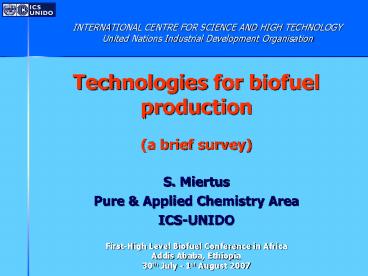Technologies for biofuel production (a brief survey) - PowerPoint PPT Presentation
1 / 14
Title:
Technologies for biofuel production (a brief survey)
Description:
... non renewable energy consumed, availability ... SO2, etc.) Socio-economic criteria Comparison of technologies Economic versus environmental aspects A) ... – PowerPoint PPT presentation
Number of Views:241
Avg rating:3.0/5.0
Title: Technologies for biofuel production (a brief survey)
1
INTERNATIONAL CENTRE FOR SCIENCE AND HIGH
TECHNOLOGY United Nations Industrial Development
Organisation
- Technologies for biofuel production(a brief
survey) - S. Miertus
- Pure Applied Chemistry Area
- ICS-UNIDO
- First-High Level Biofuel Conference in
AfricaAddis Ababa, Ethiopia 30th July - 1st
August 2007
2
Biofuel value chain and UNIDO radius of attention
Biomass resources
Supply systems
Conversion
End products
Oil bearing plants Agricultural crops and
residues Woody biomass Industrial andmunicipal
waste
Harvesting, collection, handling, and
storage
Transportation fuels (biodiesel, bioethanol)
Chemical(transesterification)
Solid fuels(wood pellets, charcoal)
Physical chemical(extraction)
Biochemical(fermentation)
HeatElectricity
Thermochemical(gasification)
High added-value chemicals (pharmaceuticals,
polymers)
byproducts
UNIDO (ICS-UNIDO expertise)
UNIDO and FAO
FAO
UNIDO and UNCTAD
3
Overview of Biofuel Production TechnologiesFirst
Generation of Biofuels
Biofuel type Specific name Feedstock Conversion Technologies
Pure vegetable oil Pure plant oil (PPO), Straight vegetable oil (SVO) Oil crops (e.g. rapeseed, oil palm, soy, canola, jatropha, castor, ) Cold pressing extraction
Biodiesel Biodiesel from energy crops methyl and ethyl esters of fatty acids Biodiesel from waste Oil crops (e.g. rapeseed, oil palm, soy, canola, jatropha, castor, ) Waste cooking/frying oil Cold and warm pressing extraction, purification, and transesterification Hydrogenation
Bioethanol Conventional bio-ethanol Sugar beet, sugar cane, grain Hydrolysis and fermentation
Biogas Upgraded biogas Biomass (wet) Anaerobic digestion
Bio-ETBE Bioethanol Chemical Synthesis
4
Overview of Biofuel Production TechnologiesSecond
/Third Generation Biofuels
Biofuel type Specific name Feedstock Conversion Technologies
Bioethanol Cellulosic bioethanol Lignocellulosic biomass and biowaste Advanced hydrolysis fermentaion
Biogas SNG (Synthetic Natural Gas) Lignocellulosic biomass and residues Pyrolysis/Gasification
Biodiesel Biomass to Liquid (BTL), Fischer-Tropsch (FT) diesel, synthetic (bio)diesel Lignocellulosic biomass and residues Pyrolysis/Gasification synthesis
Other biofuels Biomethanol, heavier (mixed) alcohols, biodimethylether (Bio-DME) Lignocellulosic biomass and residues Gasification synthesis
Biohydrogen Lignocellulosic biomass and biowaste Gasification synthesis or biological process
Use GMO as a feedstock to facilitate hydrolysis
/ technologies for hydrogen production
5
Comparison of technologiesTechnology aspects
c
d
Techn
.
Overall efficiency
Expected plant
Current stage of
Distri
-
Use
a
b
d
Effort
capacity
development
bution
MW
bf
Many different concepts for biofuel options of
the 2nd generation associated with appropriate
benefits and bottlenecks along the pathway.
a
regarding system complexity
(
less promising
.
very promising
)
b
related to biomass feedstock
c
according state of development
(
many different concepts
)
only theoretical values
d
suitability for current distribution and use
(
less promising
.
very promising
)
Source IEE Leipzig, 2007
6
Overall biorefinery concept - a new chemical
industry sector
- equivalent to the petrochemistry concept
7
Biomass to high added value chemicals, an
emerging chemistry
Biomass
Extraction of chemicals
Biodiesel production
Sugar fermentation
Thermochemicalconversion
- Ethanol
- Lactic acid
- Proteins
- Vitamins
- Fragrances
- Pharmaceuticals
Glycerol
Bio-SNG
Chemicals
Chemicals
Chemicals
8
DST conceptBiofuel/biofuel production technology
selection criteria
- Technological criteria (energy content, non
renewable energy consumed, availability, carbon
residue, sulfur content, viscosity, density,
efficiency, scale up, ) - Financial criteria (static, dynamic, risk)
- Environmental criteria (CO2 , CO, NOx, SO2, etc.)
- Socio-economic criteria
9
Comparison of technologies Economic versus
environmental aspects
Source IEE Leipzig, 2007
10
Selected ICS-UNIDO activities 2006/2007
Renewables to biofuels and biobased products
- A) Awareness and capacity building
- EGM on Technologies for Exploitation of
Renewable Feedstock and Waste Valorisation,
20-30 May 2006 Trieste, Italy - Workshop on Sustainable Plastics and chemical
products from renewable resources, Belgrade,
Serbia Montenegro, June 2006 - Workshop on Bio-fuels from palm oil emerging
technologies and their assessment 4 July 2007,
Malaysia - Workshop on Technologies for renewable feedstock
exploitation and bio-fuels production Accra,
Ghana, December 2007 in cooperation with UNIDO
ECB branch - Joint event in Senegal, February 2008
- Promotion of joint pilot projects in Africa
(UNIDO ICS)
- B) In house development of expertise tools
- Survey of technologies for exploitation of
renewable feedstock for biofuels (technological,
economic, environmental parameters) - Decision support tool for assessment of
technologies for renewable feedstock exploitation
- Molecular modelling of chemical processes
(catalysis, separation, etc.) - Strategies for developing countries
11
Example 1 Malaysia ICS-UNIDO-MPOB cooperation
proposal
- Catalytic processes for exploitation of palma
biomass - Project 1 Transesterification
- Solid basic catalysts (supported alkali and
alkaline earth metal oxides/salts, modified or
pretreated Group II-III metal oxides,
hydrotalcite-like materials, alkali exchanged
zeolites and molecular sieve materials, strong
organic bases grafted on inert support, super
bases) - Project 2 Glycerol based syntheses and products
- Substitute for polyols (microbiological and
catalytic conversion of glycerol to 1,3
propanediol) - Polymeric materials.
- Glycerol as fuel (bio-transformation of into CO
and methane, synthesis of glycerol tertbutyl
ether as gasoline additive, catalytic
transformation of glycerol into CO/CO2 and H2) - Carbonatation of glycerol (glycerol carbonate is
a good protic polar solvent) - Project 3 Catalysts for palm oil biomass
gasification
12
Example 2 2008 GREENOLYMP (Green Olympics,
Beijing) a project for green plastics
Agro food waste (by product of cheese
production)
Alcaligenes latus Cells for the production of
environmentally degradable plastics
1st to 45th day
The biosynthetic pathway of PHB and P(HB-HV) in
Alcaligenes eutrophus
The general structure of polyhydroxyalkanoates
13
- Recent ICS-UNIDO publication
- BIO-FUELS
- Technologies Status and Future Trends
- Feedstock and Product Valorisation
- Assessment of Technologies and DSTs
- 2007
- Authors
- A. Sivasamy1, P. Foransiero1, S. Zinoviev1, S.
Miertus1 - F. Mueller-Langer2, D. Thraen2 A. Vogel2
- 1 ICS-UNIDO, Trieste, Italy
- 2 IEE, Leipzig, Germany
- Available at ICS-UNIDO website
www.ics.trieste.it
14
THANK YOU
Stanislav.Miertus_at_ics.trieste.it
www.ics.trieste.it

